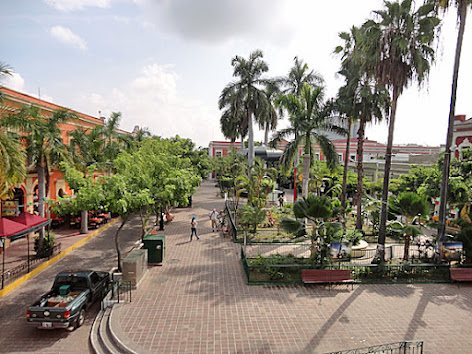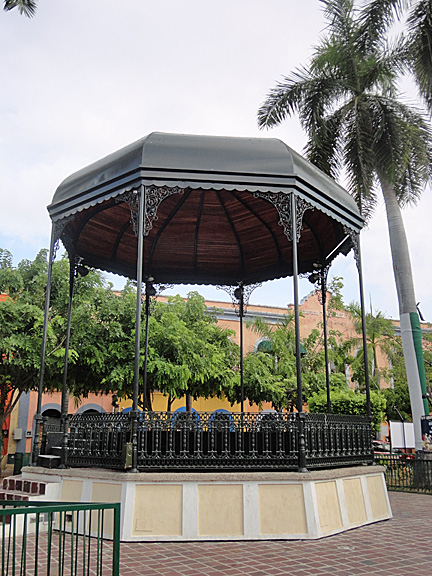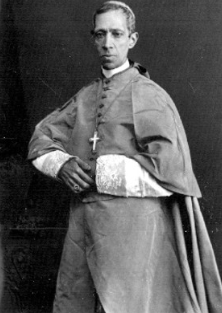From the Plaza Marchado, as we crossed the street we saw the statue of Amado Nervo (1870-1919). Amado Nervo (shown below) was a poet who lived in a wooden house in Olas Altas in 1901.
Mel walks across the street to the Edificio Medrano on the corner of Calle Mariano Escobedo and Calle Cranaval in Old Mazatlán. Note the unique wooden curved door. The building is known as Edifice Medrano in honor of the family that built it. The first reference to the building site dates to 1850 when the property was owned by businessman General Antonio Grosso, another of the rich landowners of the day. By 1920, the Medrano family owned the property and erected the two story edifice that stands today.
We continued along Carnaval and then turned on 21 de Marzo and followed it past the City Hall on the right with the Plaza de la Republica on the left (see map below).
The Mazatlan City Hall is over 140 years old, and since we are here around Carnaval, it is decorated with glittery Carnaval Mazatlan decorations (see below).

The Plaza de la Republica faces the magnificent Basilica de la Immaculada Concepcion, Mazatlan's largest Catholic church and the Mazatlan City Hall. Originally constructed in 1870, at the center of Plaza de la Republica we found a lovely ironwork Porfirian bandstand that was constructed in 1909. The plaza has large palm trees that provide shade and verdant foliage that gives the entire space a tropical feel. There are numerous vendors and a distinct concentration of shoe shine and shoe repair stalls.
Shown above is a 19th Century map of Old Mazatlán. Indigenous people had inhabited the area for thousands of years before the Spanish under Nuño de Guzman arrived in 1531 to set up a port to handle exports of gold and silver found in mines in the area. The top of this map faces west and the bottom faces east. At the top of the map, Olas Altas beach is bracketed by Cerro de las Neverias (Icebox Hill) on the right, and Cerro del Vigia (Lookout Hill) on the left. Plazuela Machado is three blocks east of Playa Olas Altas.
We walked all around the Plaza de la Republica (see pictures above and below).
Mel walked over to the OXXO to get a beer and a bottle of water for me. We sat on the bench in Plaza de la Republica for a little while.
We found several shoe shine and shoe repair stalls (see above and below).
Near the gazebo, a monument to military heroes stands. It's the Brigada Sinaloa, which celebrated 100 years in 2010 (see above).
Before we walked across the street to see the beautiful Immaculate Conception Cathedral, we stopped to take a picture of the glitzy Mazatlan sign (see below with Mel peeking out between the letters "Z" and "A."
Next we walked across the street to see the crowning glory of Mazatlán’s Old Town -- the 19th-century cathedral that bears Gothic and Moorish influences and has a striking collection of stained-glass windows.
With its soaring towers, elegant cupola and imposing scale, the Immaculate Conception Cathedral dominated the historic center of Mazatlán. We marveled at its architecturally impressive façade and discovered a lavish interior with chandeliers, icons, frescoes and mosaics.
The cathedral covers an entire city block in Mazatlán’s Old Town. Construction of the church began in 1856 and it took more than 40 years to complete. We walked around the exterior to fully appreciate its vast size and to survey its Gothic and Moorish features. We then gazed up at the twin towers, which rise above a main entrance adorned with sculptures. Crowning the cathedral was a large yellow-tiled cupola flanked by smaller domes.
Shown above is Spanish Bishop Juan de Zumárraga kneeling before the image of the Virgin of Guadalupe. Most Mexican religious art depicting the story of the Virgin of Guadalupe, either shows her alone in her classic pose, or includes Juan Diego, the indigenous man who first encountered her in the early 16th Century.
The statue above that we found to the right of the Cathedral entrance was unusual in showing a different aspect of this story. Bishop Zumárraga had been very skeptical that the Virgin had really appeared before this lowly person. He asked for proof. Juan Diego returned to the ruined Aztec temple and the Virgin told him to collect flowers (traditionally roses) from the hill on which the temple was located. Juan Diego returned to the bishop with a cloak full of miraculously out-of-season flowers (as it was winter). Opening the garment, both he and Bishop Zumárraga were astonished to find the image of the Virgin imprinted on the fabric. That moment is captured in the statue above and below.
Shown above are the doors to the inside of the cathedral. Inside, the cathedral was a true artistic gem, with Gothic arches supporting elegant Renaissance-style domes. The gilded Baroque altar was adorned with statuettes and featured an image of the Virgin of the Immaculate Conception. The exuberant interior also had embossed wall decorations, graceful chandeliers and murals. The cathedral has an extravagant organ that was built by the famed French organ builder, Aristide Cavaillé-Coll.
Begun by the Bishop Pedro Loza y Pardave (see above) in 1856, the central Mazatlan Cathedral was built on the site of an ancient Indian temple. Mazatlan's turbulent history delayed the completion of the church until 1899. In 1937 -- after additional work -- the church was elevated to the status of a "basilica" -- that of a Roman Catholic church given special ceremonial privileges by the Pope.
Inside the Basilica, the image of the city's patron saint, the Virgin de la Purisima Conception floats over the gilded, baroque main altar. Overhead, soaring rounded Renaissance domes and gilded Gothic arches create an airy and spiritual space.
Shown above was the interior of the main nave of the Cathedral. The style of the church was very eclectic, combining Moorish, Gothic, Baroque, and a touch of Neo-Classic. The steeples, which were completed between 1893-1894, were covered by yellow tiles manufactured in Europe. The main altar contained magnificent statues of saints and angels made of Italian marble, as well as the jewel of the church -- a relief carving of the Last Supper.






Shown above, the main altar was covered by a lovely cupola. The octagonal cupola formed the interior of the dome seen below in the next picture. The cupola contained four paintings, two of which are shown above. The arch was decorated by the Spanish version of a quote from Jesus, "Come to me all who are afflicted and I will console you."
San Ambrosia occupied one of the four corners below the octagonal cupola. The other three paintings were of San Bernardo and the Old Testament Prophets Zacarias and Moses. St. Ambrose was one of the Four Doctors of the Catholic Church who were considered its greatest theologians. While he was a great theologian, he also advocated violent action against synagogues, becoming one of the earliest anti-semitites.
He successfully protested the Roman Emperor's order to rebuild a synagogue destroyed by a mob. This led to similar anti-semitic destruction all over the Empire of which St. Ambrose explicitly approved. St. Ambrose successfully confronted several of the Roman Emperors of his time, persuading them to reverse their stances on religious issues and to support the Catholic theological positions.
Shown above is the ceiling of one of the four lateral naves. Two of these naves were on either side of the main altar, and the others bracketed the main entrance. The ceilings showed Neo-Classic influence. The four naves were dedicated to the Virgin of Rosario, the Sacred Heart of Jesus, San Jose, and the Virgin of Guadalupe.
Shown above was one of the Basacilica's unique architectural features -- its 28 stained glass windows incorporated a Star of David. Legend has it that this gesture was in gratitude for the donation of cionstruction funds by the Mazatlan Jewish community.
Near the front entrance was one of many statues in the Cathedral. The beautiful purple robe contrasted nicely with the alternating light and dark stone blocks of the wall. According to a nearby sign, this church did not become a basilica cathedral and the seat of Mazatlan's diocese until 1958 -- 103 years after construction was begun.
Shown above was the Nave of the Virgin of Guadalupe -- where if Catholics could light a candle, which was a traditional Catholic ritual.
After our visit to the church, we went to the big market between the street of Melchor Ocampo and Leandro Valle (see map below). The Mercado Pino Suarez (or Mazatlan's central market) is a busy indoor marketplace that has been open since 1900 with vendors of produce, meat, handicrafts and apparel.
Shown above is the Mercado Pino Suarez market. This large market was formerly known as Jose Maria Pino Suarez Market. It opened in 1899 with the name Manuel Romero Rubio and then the name was changed in 1915 to Jose Maria Pino Suarez in honor of the vice president of Mexico, who was shot in 1913. The market had several entrances. As of 2017, the market boasted 260 stalls! One of the entrances had a meat section where there were the very pungent and sharp smells of pig's heads proudly displayed along with other hanging meat. Just beware, because on warm days there could be a lot of flies as well.
The second story level of the market was packed with local restaurants (that were installed in 1952 out of the previous storage area). The market was divided in sections by food types. There were aisles with fresh seafood, chicken, beef and pork -- and miles of aisles of fresh fruits and vegetables. The market also had cheese vendors -- featuring some delicious locally produced farmers cheeses -- as well as herb and spice shops. Beyond food, the market had numerous shops and vendors of tourist items, like t-shirts, hats, and all sorts of souvenirs representing a day of sightseeing in the Centro Historico.
Shown above, the handmade dolls eagerly awaited new owners. Mercado Pino Suarez sold a wide variety of goods, not just food. They also had jewelry, shoes and other leatherwork, hand-embroidered dresses, and much more. And even if you didn't make any purchases, a walk through the Mercado was entertaining in its own right.
Shown above and below are pictures of the exterior of Mazatlán’s Pino Suárez Mercado. This 1899 structure was built of iron and steel in the art nouveau style of the Eiffel Tower, which had been constructed just a few years earlier. The area was lively with busses, cars, taxis, and hordes of people!

The mercado (market) is located about five blocks from the Plazuela Machado, and it occupies a city block between Aquilles Serdan and Benito Juarez and Melchor Ocampo and Leandro Valle.
In 1895, the construction of the market was ordered as the markets that existed at that time that were operated outdoors had unhealthy conditions. The market was designed by Alejandro Loubet Guzmán and took 5 years to build. It was founded on May 5, 1899, with the name of Mercado Manuel Romero Rubio, and was inaugurated by the then governor of the state Guillermo Cañedo.
On February 14, 1915, its name was changed to Mercado Pino Suárez in honor of the vice president of Mexico José María Pino Suárez, who was assassinated a year after visiting Mazatlán in 1913. The market has undergone several changes over time; during the first years of its existence on Benito Juárez Street there was a wide esplanade, where diners were installed; after 1910, the outside of the market was filled with stalls and in 1910, the city council authorized the installation of permanent stalls around the market. In 1951, renovation works were carried out on the market.

There were lots of vendors outside the mercado – pictured above was a cart that would be pushed home every evening. On this end of the cart were the delicious coconut treats called cocadas.
Here was another cart outside the mercado with more coconut treats, lovely dates, gumdrops, and in the foreground cucumber and watermelon.
There were numerous small “comida economica” or cheap food stands both outside the mercado (like the one shown above) and throughout the entire upper floor.
And with the warm year-round climate, fruit drinks like those shown above were very popular and refreshing.
The mercado was not just for fresh food and meat. It truly had pretty much anything needed. Shown above was a Café El Marino stand. This large coffee company was founded in 1950 in Mazatlán.
Shown above were some of the many types of beans, garlics, lentils, and spices.
This fruteria was one of the at least 40 different vendors of fruits and vegetables in the mercado. This photo showed the interior steel structure of the mercado as well.
There were also a number of small grocery stores within the market. Even if they looked small, they truly had it all.
Shown above was a cremeria (where cream was made). They had cheese, yogurt, milk, and other dairy products, as well as packaged tortillas, too.
Shown above was a panaderia (bakery) -- lots of sweet goodies.
And as shown above and below, there was an abundance of fresh fish. Almost certainly, many of these were still swimming off the coast only a few hours ago.
There were many stands of meat -- chicken, beef, pig heads, as well as hanging meat as shown below.
Pig's heads anyone? There were many unusual delicacies at the Mercado Pino Suarez.
This smiling fellow shown above would probably rather be somewhere else, don't you think?

After going through the Mercado Pino Suarez, we headed back.
We walked around the other side of the cathedral.
Shown above was the Canobbio's Arcade that occupied the west side of the Plazuela along Calle Heriberto Frias. The Arcade, which occupied the whole length of the block, was named after the Canobbio family, who maintained a drug store here in the late 19th Century.
Above the Arcade was the Museo Machado (opened in 1999), that recreated the lifestyle of prosperous 19th Century Mazatlecos, as the locals like to be called. Originally the building had only one floor and was called Portal de la Lonja. In 1864, the second story was added by architect Juan Modini and the building took on the look you see today.
We soon arrived back at the Plazuela Machado. I walked around and took a couple pictures of the beautiful large Madri Gras lady statue in the plaza (see above and below).
We decided to sit down on one of the benches in the Plaza Machado. It was a beautiful rectangular-shaped square in the Historic Old Town of Mazatlán. The interior was primarily palm trees and gardens, but there was also a large gazebo. The outside was a walkway lined with benches.
I sat there while Mel got us something to drink. After Mel came back with drinks, I took a peek at the t-shirts we had bought at the Mercado (market), but after discovering that the t-shirts didn't say anything about Carnaval Mazatlan or the Eclipse Barroco, Mel decided to walk back over to the big market to find the right t-shirts, while I waited here.
Shown above is one of the vendors in the square across from the bench I was sitting on waiting for Mel to return.
Shown above and below was an interesting thinking statue I saw in the square.
Shown above in the square was a lady playing guitar right by the tree in front of the hotel with lots of streamers and homemade beads hanging from it.
Shown above is one of the brightly colored Carnaval Mazatlan black t-shirts we got from Mazatlan.
* * * * * * * * * * * *
INFORMATION ON CARNAVAL CELEBRATION IN MAZATLAN
Carnaval (as it is spelled in Mazatlan) was the biggest annual event of the year in Mazatlán! It was more like a festival and consists of many events including huge parades, large coronations, large concerts, fireworks, and street parties with hundreds of thousands of people there!
Carnaval was a Christian tradition that celebrated the short period before Lent began -- running from Thursday, February 8 to Tuesday, February 13, 2024 (known a Mardi Gras Day or Fat Tuesday). Tuesday, February 13 was significant in the Catholic religion because it was the last day of feasting before Lent began on Ash Wednesday.


.png)





















































































































































































No comments:
Post a Comment